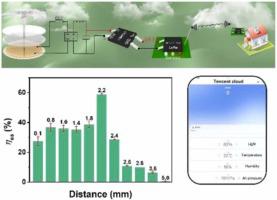当前位置:
X-MOL 学术
›
Nano Energy
›
论文详情
Our official English website, www.x-mol.net, welcomes your
feedback! (Note: you will need to create a separate account there.)
Enhancing the output energy of triboelectric nanogenerator by adaptive arc discharge devices and its application in wireless weather sensing system
Nano Energy ( IF 16.8 ) Pub Date : 2024-07-11 , DOI: 10.1016/j.nanoen.2024.109987 Wenhe Zhang , Guangqin Gu , Zhihao Zhang , Hengxian Ren , Hanyan Zhou , Yingying Gui , Zuliang Du , Gang Cheng
Nano Energy ( IF 16.8 ) Pub Date : 2024-07-11 , DOI: 10.1016/j.nanoen.2024.109987 Wenhe Zhang , Guangqin Gu , Zhihao Zhang , Hengxian Ren , Hanyan Zhou , Yingying Gui , Zuliang Du , Gang Cheng

|
Combined with power management circuit (PMC), triboelectric nanogenerator (TENG) has expanded its application in self-powered systems, but the switches suitable for TENG are still in research. Compared with mechanical switches and electronic switches, gas discharge devices are promising due to the advantages of light weight, easy integration, voltage adaptability, stability in both discharge voltage and longtime operation. Here, a TENG driven tip-tip electrode air discharge switch (T-TADS) is developed for significantly improving the output performance of triboelectric nanogenerator and energy storage efficiency (η es ) of PMC. Compared with the same TENG without T-TADS, the maximum instantaneous power on external resistance lower than 1 MΩ are enhanced by 1600 times. Combined with passive PMC, the η es reaches 58.9 % when the tip-tip distance is 2.2 mm. To extend the versatility of gas discharge switches, gas discharge tubes (GDTs) with stable breakdown voltage (V br ), small size, light weight (∼ 0.9 g), and easy integration characters are also measured. The results show that GDTs have similar electrical properties to the T-TADS, and the maximum η es is 56.3 % when the V br is 1000 V. Finally, based on a wind driven TENG and PMC including a GDT, a self-powered wireless weather sensing system is developed, which can transmit temperature, humidity, air pressure, and light intensity every 11 minutes with a maximum distance of 800 m. The self-powered wireless weather sensing system has potential application at areas such as high altitudes, deserts, and mountains.
中文翻译:

自适应电弧放电装置增强摩擦纳米发电机输出能量及其在无线气象传感系统中的应用
结合电源管理电路(PMC),摩擦纳米发电机(TENG)扩大了其在自供电系统中的应用,但适合TENG的开关仍在研究中。与机械开关和电子开关相比,气体放电装置具有重量轻、易于集成、电压适应性强、放电电压稳定、可长时间工作等优点,具有广阔的应用前景。在此,开发了一种TENG驱动的尖端电极空气放电开关(T-TADS),以显着提高摩擦纳米发电机的输出性能和PMC的能量存储效率(ηes)。与相同的没有T-TADS的TENG相比,在外部电阻低于1MΩ时的最大瞬时功率提高了1600倍。结合被动PMC,当尖端距离为2.2 mm时,ηes达到58.9%。为了扩展气体放电开关的多功能性,还测量了具有稳定击穿电压(Vbr)、小尺寸、轻重量(∼0.9 g)和易于集成特性的气体放电管(GDT)。结果表明,GDT具有与T-TADS相似的电特性,当Vbr为1000 V时,最大ηes为56.3%。最后,基于风力驱动的TENG和包含GDT的PMC,一种自供电无线天气传感开发了系统,可以每11分钟传输一次温度、湿度、气压和光照强度,最大距离为800 m。自供电无线气象传感系统在高海拔、沙漠、山区等地区具有潜在的应用前景。
更新日期:2024-07-11
中文翻译:

自适应电弧放电装置增强摩擦纳米发电机输出能量及其在无线气象传感系统中的应用
结合电源管理电路(PMC),摩擦纳米发电机(TENG)扩大了其在自供电系统中的应用,但适合TENG的开关仍在研究中。与机械开关和电子开关相比,气体放电装置具有重量轻、易于集成、电压适应性强、放电电压稳定、可长时间工作等优点,具有广阔的应用前景。在此,开发了一种TENG驱动的尖端电极空气放电开关(T-TADS),以显着提高摩擦纳米发电机的输出性能和PMC的能量存储效率(ηes)。与相同的没有T-TADS的TENG相比,在外部电阻低于1MΩ时的最大瞬时功率提高了1600倍。结合被动PMC,当尖端距离为2.2 mm时,ηes达到58.9%。为了扩展气体放电开关的多功能性,还测量了具有稳定击穿电压(Vbr)、小尺寸、轻重量(∼0.9 g)和易于集成特性的气体放电管(GDT)。结果表明,GDT具有与T-TADS相似的电特性,当Vbr为1000 V时,最大ηes为56.3%。最后,基于风力驱动的TENG和包含GDT的PMC,一种自供电无线天气传感开发了系统,可以每11分钟传输一次温度、湿度、气压和光照强度,最大距离为800 m。自供电无线气象传感系统在高海拔、沙漠、山区等地区具有潜在的应用前景。











































 京公网安备 11010802027423号
京公网安备 11010802027423号